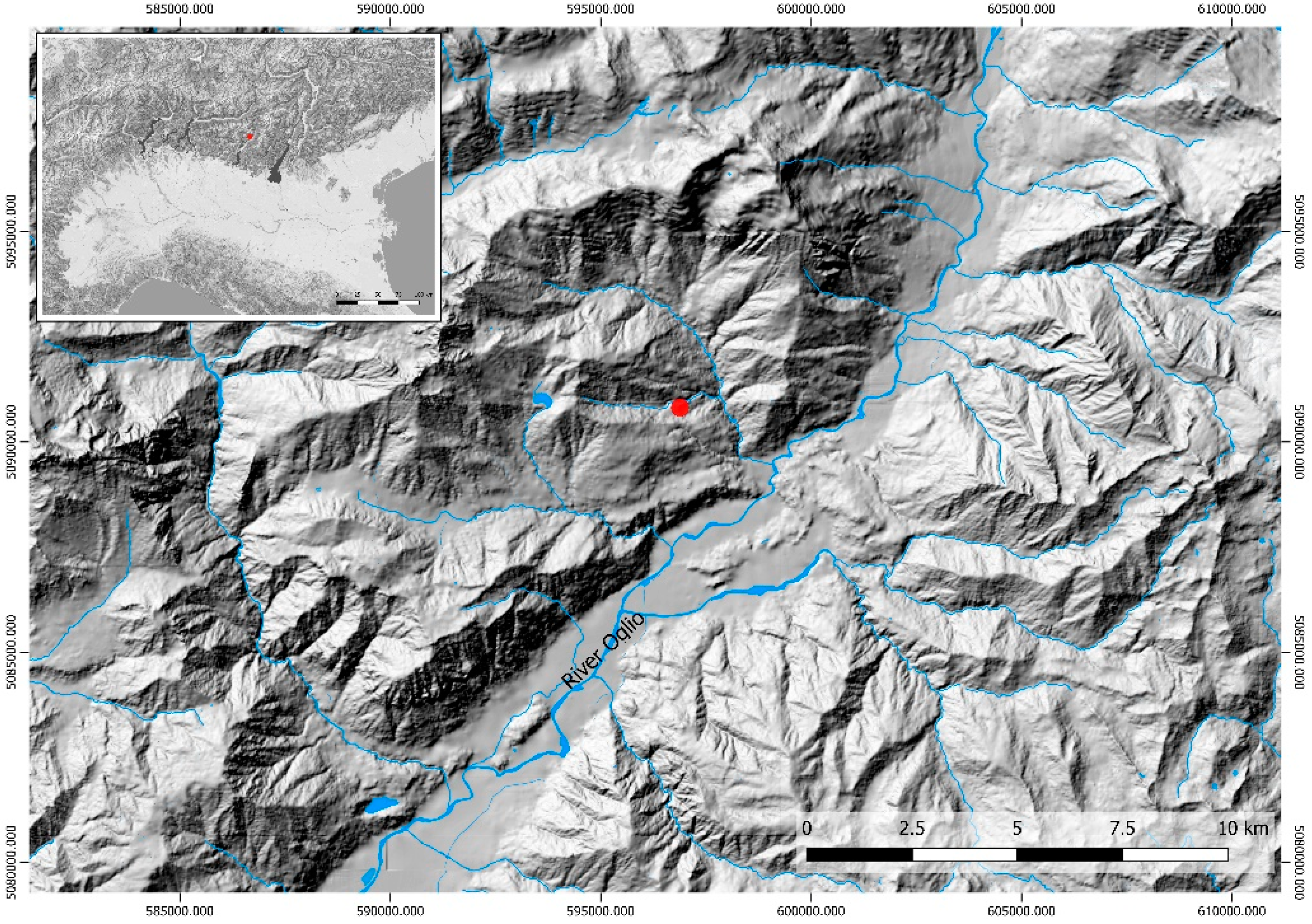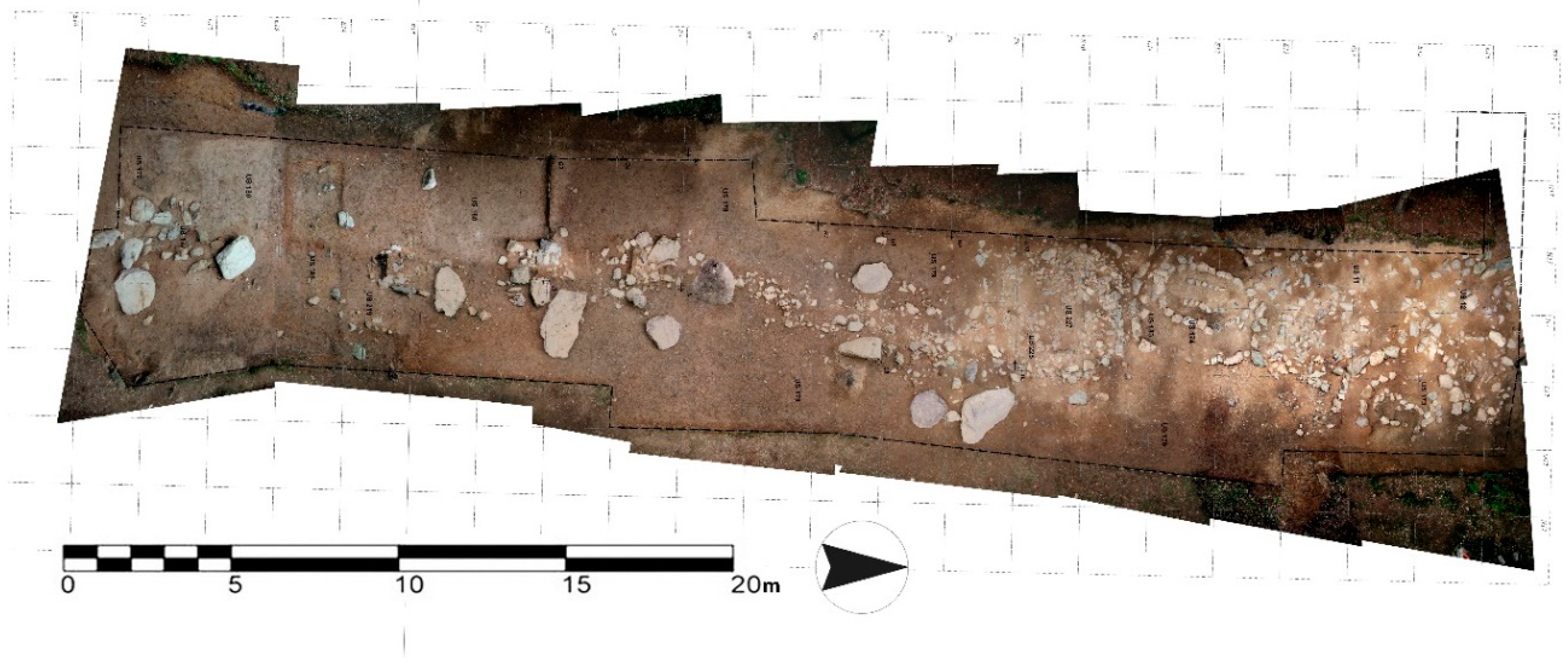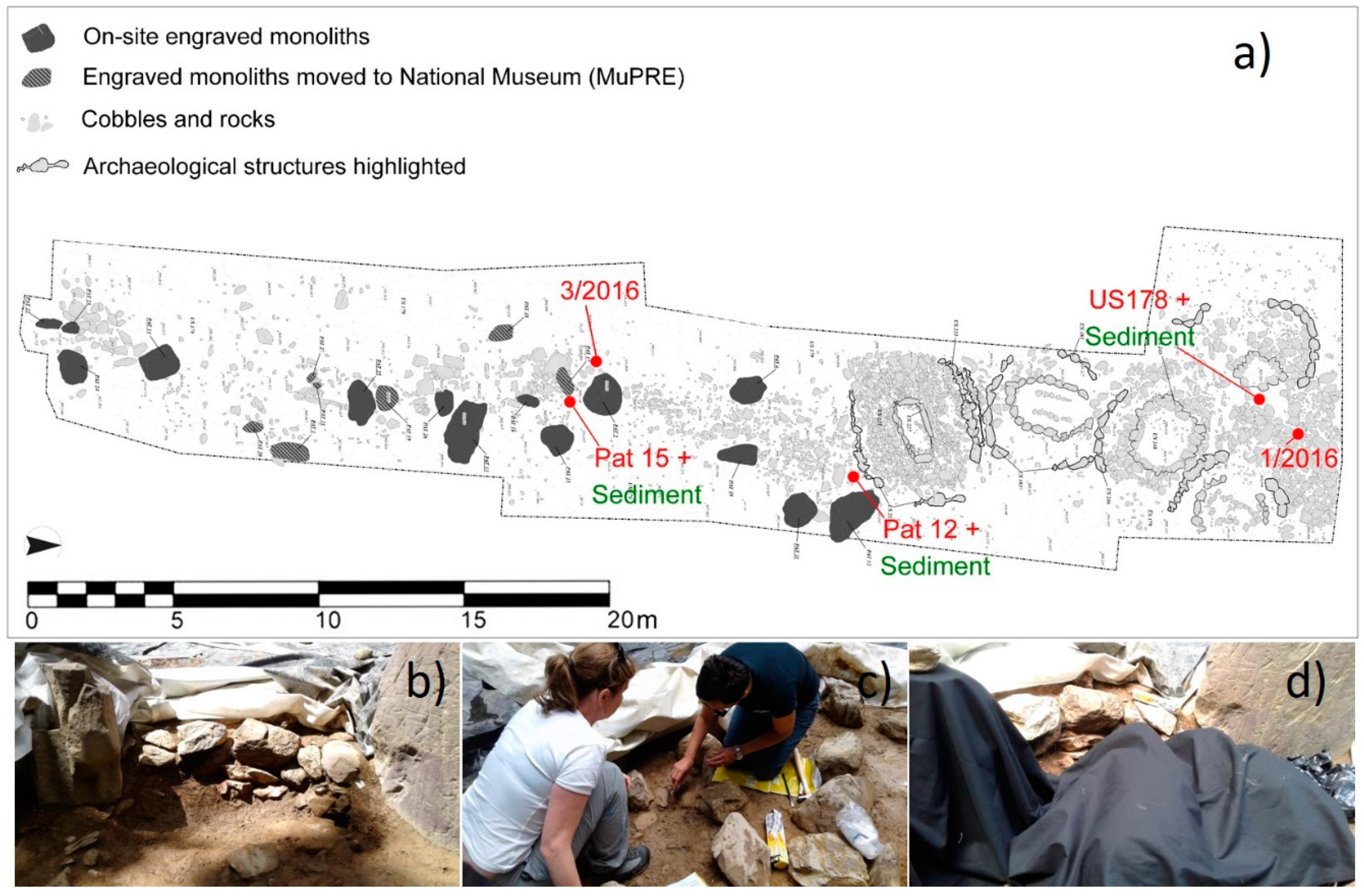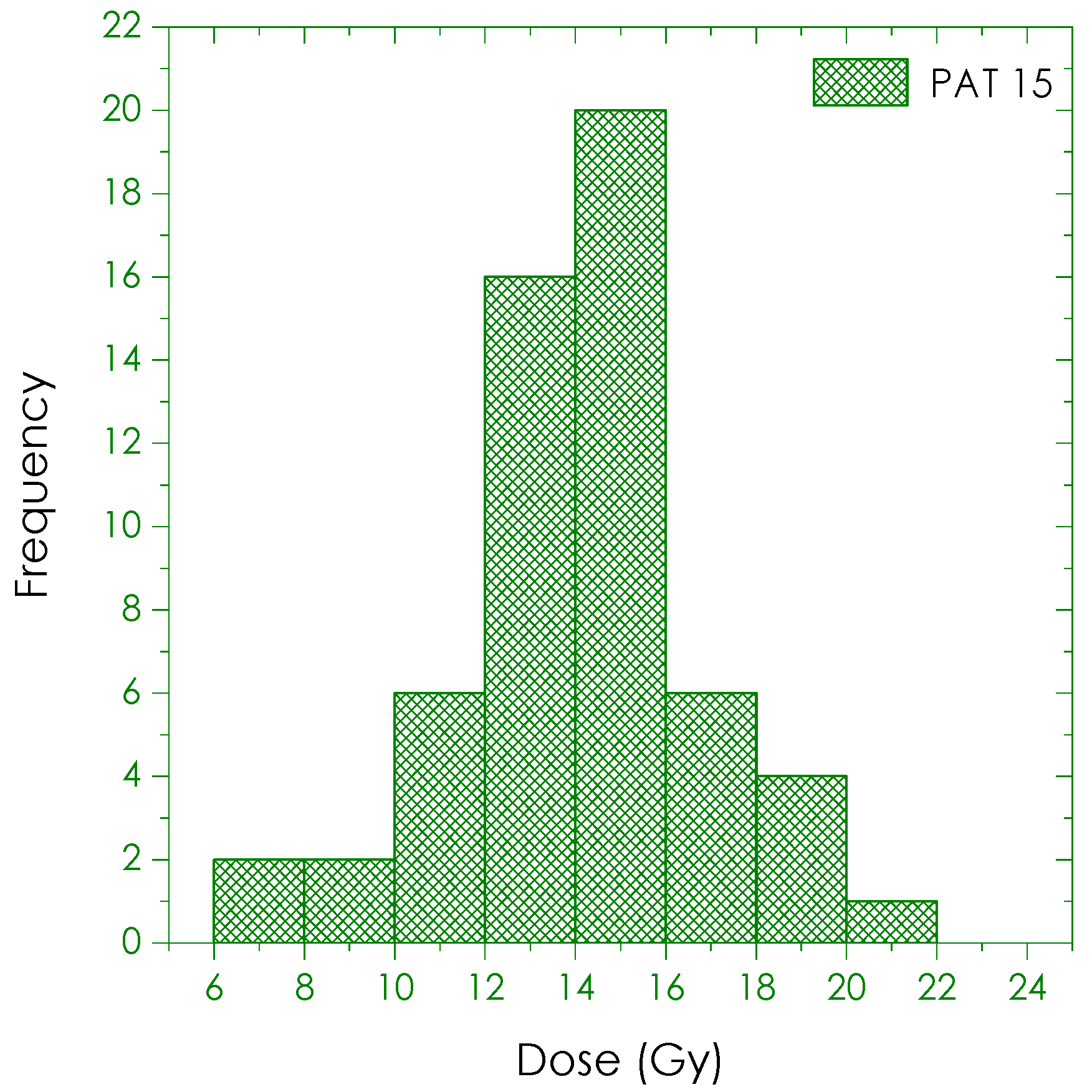1. Introduction
There are many examples of rock surfaces, rock art and stone structures of unknown age. In particular, in prehistoric archaeology, long-lasting building traditions can sometimes be difficult to date, if the context does not offer useful chronological tools, such as artifacts or organic remains associated to the structures. Moreover, this particular issue is not a marginal one, if we consider that the study of megaliths, drystone walls and other structures, such as cairns or mounds, is often crucial to our understanding of the society and traditions of very ancient cultures, devoid of other forms of communication.
In this scenario, the Ossimo-Pat (Valle Camonica, BS, Italy, see
Figure 1) megalithic sanctuary is an exemplary case.
Its construction started in the first half of the fourth millennium BCE and was structured and used during the Copper Age (late 4th–3rd millennium BCE), with ceremonial structures and engraved monoliths articulated in a north-south alignment. The southernmost structure is a sequence of ceremonial mounds, built upon a concentric series of stone circles enclosing an inner rectangular space, which usually contained objects, such as flint weapons and tools or ornaments. The central part of the sanctuary was an alignment of monoliths of various lithologies, mainly sandstones of diverse granulometry, carved with figures and symbols and probably depicting mythical ancestors or gods. The alignment led to a monumental tomb and then to a series of at least five votive stone circles, which contained, similarly to the southern mounds, a number of flint, stone, metal and ceramic artefacts, probably the result of unknown cult activity [
1,
2]. The site was frequented until its sudden, partial, dismantling and further abandonment, at the very beginning of Bronze Age, at the end of the 3rd millennium BCE. Later frequentation during the final Bronze Age and the whole Iron Age is attested by a series of fireplaces that were lit in front and at the backside of the monoliths still vertically standing. Ossimo-Pat is one of the most relevant archaeological findings of the southern alpine region, for the variety of its structures and the quality of its engraved monoliths, as well as for its unique state of preservation, which gives the opportunity for a documentation of the exact moment of its disuse. As part of the UNESCO World Heritage Site n.94 “Rock Drawings in Valle Camonica,” the sanctuary occupies an area of more than 4000 square meters, and it is located on the right hydrographic flank of the medium Valle Camonica, at an altitude of 810 m asl. The site is arranged on the edge of a terrace overlooking a steep drop into the Valle dell’Inferno (the strikingly named “Valley of Hell”), placed on a wide elevated plateau comprised by two dominant peaks: the Pizzo Camino (2491 m asl) to the southwest and the Concarena (2549 m asl) to the north-east. The rocky substrate of the area is mostly made of Triassic (from the Scitic to the Carnic) limestones, while the surfacing lithology is often covered by morainic deposits, left by the glaciers, which can be encountered up at an altitude of 1650 m asl. (source: F. Franzoni, Piano di Governo del Territorio, Comune di Ossimo, 2012 (
http://www.comune.ossimo.bs.it/Allegati/all_50012_GEO_Relazione%20Geologica.pdf)). The monoliths chosen to be engraved are very likely coming come from these deposits, but the geological survey and study is still ongoing. Excavations and analyses are being carried on since 1994 and are still ongoing, under the direction of Raffaella Poggiani Keller (
Figure 2).
There are two potential methods for dating the surfaces of such artefacts: the measure of cosmogenic radionuclides concentrations [
3] and the application of luminescence dating (in particular Optically Stimulated Luminescence, OSL) [
4,
5]. The first approach depends on cosmogenic nuclides (e.g.,
10Be,
26Al,
36Cl) build-up with time in minerals exposed to cosmic rays. Therefore, measuring their concentrations allows determination of how long rocks have been exposed at or near the surface of the Earth. In this paper, we focus on the alternative approach based on OSL. This method was originally developed to date the deposition of sediments [
6] and it depends on the ability of some minerals, such as feldspar and quartz, to absorb and store energy from environmental ionizing radiation. When the light stimulates these minerals, they release the stored energy in the form of light, from which the term luminescence is derived. Measuring the amount of energy released in conjunction with a determination of the rate at which the energy was accumulated allows to calculate an age, indicating the time that has elapsed since the storage of energy began.
Thus, if the OSL signal from mineral grains is normally used to date how long the sediment grains were buried, recent works have shown that luminescence signals can also be used to determine the duration of daylight exposure for rock surfaces [
4,
7,
8,
9].
The OSL surface dating technique exploits the depth-dependence of the resetting (bleaching) of the geological luminescence signal when exposed to daylight. Sohbati et al. [
4,
10] proposed a model that reproduces the dependence of the OSL signal on depth and exposure-time and predicts that the longer the exposure duration, the deeper the resetting of the luminescence signal into the rock surface. Analogously, this dependence has been evaluated for renaissance bricks [
11].
Thus, there exists chronological information in the luminescence-depth profile, but despite some applications of the OSL surface technique [
8,
9,
12], the bleaching-depth model is yet to be validated experimentally; this is critical for further development of the technique. The emerging OSL surface dating technique has the potential to answer many new questions in the fields of geo- and archaeological sciences.
Dating the sanctuary was mostly done through the combination of stratigraphy observations, typo-chronological study of the artefacts and with the use of a certain number of radiometric measurements (14C) on charred coals from different parts of the site [
1], mostly from the southern mounds and the upper layers of the monoliths alignment. Therefore, to test the capability of the surface dating technique, five pebbles were collected from three different areas. Three samples consisted of the pebble itself and the sediment collected directly underneath the pebble. Dating was attempted on both the underside of the pebble and on the sediment under the pebble, on the assumption that neither has been exposed to light since the placement of the rock. In this way, we checked the predictability of the reconstructed luminescence profiles into the buried rock surface.
The measured ages obtained from buried surfaces are in good agreement with those obtained from the sediments and with those obtained through archaeological methodology. Moreover, in some cases the ages obtained with luminescence dating are consistent with available 14C ages.
2. Materials and Methods
All experiments in this study were performed using rock samples and sediments collected from the Ossimo-Pat sanctuary (
Figure 3). The Sample “3/2016” is a pebble taken from the stone accumulation behind the big monolith known as “Pat 2,” presumably relative to the first stage of the abandonment of the site. “1/2016” and “US 178” are samples from the northern votive stone circles, which are generally placed in the central phase of the site-life, around the first half of the 3rd millennium BCE, while the samples “Pat12” and “Pat15”were collected from the housing pits of the fallen monoliths “Pat12” and “Pat15.” All the cobbles have a diameter in the range of 100–150 mm.
To measure the OSL depth profiles and the absorbed doses, the cobbles have been drilled under dim red light in laboratory. The reached depth was checked with a digital precision caliber. The polymineral fine grain fraction with grain sized between 4 and 10 micrometers was used.
For the sediments, the quartz grains have been extracted using the conventional procedure [
13,
14,
15,
16] under dim red light and the luminescence measurements were conducted on coarse quartz grains (180–250 μm).
All samples, both cobbles and sediments, were mounted on stainless steel discs. The OSL measurements were performed with a Risø TL/OSL DA20 reader. The samples were stimulated by blue LEDS (470 ± 30 nm, 54 mW/cm
2) or by IR LEDs (λ = 830nm, 360 mW/cm
2) and the emitted photons were detected with an EMI 9235QB photomultiplier coupled with a UV filter (7.5 mm Hoya U-340) in case of blue stimulation or with a blue filter (Schott BG39/Corning 7–59 filter combination) in case of IR stimulation. Blue stimulation was used for the samples in which the main dosimeter was the quartz and IR stimulation [
13] for the samples rich in feldspars.
To evaluate the absorbed dose the Single Aliquot Regenerative dose protocol (SAR) was applied for all samples. It is a well-known standard procedure for the optically stimulated luminescence dating in which the same aliquot is irradiated, heated and illuminated, during experimental cycles that are repeated (
Table 1). The obtained signal is integrated, normalized and plotted in function of dose and the absorbed dose is calculated from interpolation of the natural signal on the constructed curve.
The pre-heat value was experimentally derived on the basis of the results of a dose recovery pre-heat plateau test [
17] (see
Table 2).
Laboratory irradiations were given using a calibrated 90Sr/90Y beta source (5.50 GBq) mounted on the Risø TL/OSL reader (dose rate: 0.23 Gy/s for fine grain; 0.12 Gy/s for coarse grain).
The absorbed dose is calculated from the weighted mean of values obtained from the analyzed aliquots (at least 10 for sample).
The annual dose-rate absorbed by the samples is due to the contribution of the internal radioactivity of the material and the radioactivity of the surrounding environment. The radioactive families 238 U, 232 Th and 40 K are, in both cases, responsible for the natural imparted dose. There are also minor contributions from 87Rb and from cosmic rays. To take into account any non-homogeneity in the external contribution, the radioactivity of a sphere of the surrounding material (30 cm diameter centered at the sampling point) has to be measured [
9]. The heterogeneity effect was considered by measuring the radioactivity concentrations of the surroundings materials, i.e., sediments and cobbles. The contribution of each material to the annual dose-rate was evaluated applying the infinite matrix approximation, with updated conversion factors [
18]. After radioactivity measurements, it is possible to assess the contribution of each layer calculating the relative volume of every material within the interaction sphere and normalizing the annual dose fractions in the age equation [
19]. 40 K concentrations were measured through atomic absorption spectrometry; 238 U and 232 Th concentrations were obtained from total alpha counting technique. Although the water content of the cobbles is negligible, the surrounding sediment material does contain water, and thus, a water content correction is needed. This was based on the one calculated using the sediment material, specifically a mean water content equal to 75% of saturation value (20 ± 10%) was used. Attenuation of the beta dose was taken into account in case of sediments for which the coarse grains fraction was used to determine the absorbed doses [
20], while alpha contribution was eliminated by an HF etching.
4. Discussion and Conclusions
The doses absorbed by the cobbles were directly derived by the aliquots taken from the first layer. Although the uncertainty in the dose is derived from the standard error of 10 aliquots, the relative error spans between 15% and 30%, it is quite high, especially if compared with that obtained with sediments (5–6%). Due the scarcity of material for each considered layer, it has been impossible to extract quartz or feldspar grains from the samples. This may have led to luminescence signals with inadequate characteristics (slow decay rate, high background) that introduced a high error in the fitting to calculate the absorbed dose.
For US178, Pat12 and Pat15, the age from cobble is in agreement with the sediment age at a level of 1 standard deviation, thus, they are consistent with each other.
From a methodological point of view, these preliminary results show that it is possible to apply luminescence dating to the surfaces of the artefacts present in the Ossimo-Pat site. Despite the high error obtained on rock surfaces, the data obtained on sediments under the rock were more precise. This suggests that for future application of surface dating of megalithic structure, it is recommended to sample both rocks and the underlying sediments in order to reduce the age errors.
Moreover, the results of the dating offer, from an archaeological point of view, an interesting feedback to the existing timeframe of the site. Even considering the range error of each date, we can compare the results with what was already established about the site, chronology-wise. The first sample (the rock “1/2016,” 2760 BCE ± 500) was taken from the northernmost of the votive stone circles. Its date is compatible with the other two samples from the nearby, similar, stone structures (samples “US 178,” rock, 2675 BCE ± 500, and sediments, 3200 BCE ± 330). There are no 14C dates available from these circles that have been dated to the first half of the 3rd millennium BCE based on the objects found inside the circles, namely a specific type of arrowheads, usually related this period. The three OSL dates from the area would seem to confirm the current chronological framework.
The IRSL date from the rock sample “3/2016” (1920 BCE ± 250) seems equally aligned with the current chronology of the site. This rock was collected from the accumulation layer located behind the big monolith called “Pat 2,” one of the few still vertically standing. The small accumulation of soil and rocks is probably related to the first stage of abandonment of the site, right after its partial destruction and dismissal, and is usually dated around the 23rd–20th centuries BCE thanks to a charred coal 14C dating [
1].
The samples taken from the monolith pits are the most intriguing ones, as we still do not have a full comprehension of the precise life cycles of these monuments. The samples taken from the housing pit of the monolith “Pat15” are related to its filling, which happened in time, after the dismissal of the site and the overthrowing of the monolith, which was pushed to the ground, out of its proper housing. The dating of rock and relative sediment (2470 BCE ± 500 and 2265 BCE ± 115, respectively) are perfectly coherent with the said action, which probably happened, as said, between the end of the 24th and the 21st centuries BCE.
The dating of the samples from the housing pit “Pat12” (Rock: 5240 BCE ± 600; sediment: 5090 BCE ± 360), on the other hand, offer a very interesting result, related back to the end of the sixth millennium BC, before the foundation of the sanctuary. Nevertheless, these dates are perfectly coherent with another dating, obtained by 14C on a charcoal sample from the layer 181 [
1], which was documented in this very sector of the site thanks to a deep stratigraphic trench. Layer 181, rich in charred coal and burnt wood, is believed to be the outcome of the very first action carried out in this place, namely a slash/burn activity, usually performed during the late Neolithic to open new pasture areas in medium and high-altitude locations. Evidently, the digging activity performed during the Copper Age to prepare the housing pit for the huge monolith “Pat12,” which is longer than 2 m and very heavy, led to reach the deeper and more ancient level of the site, to which our samples appear to belong.













